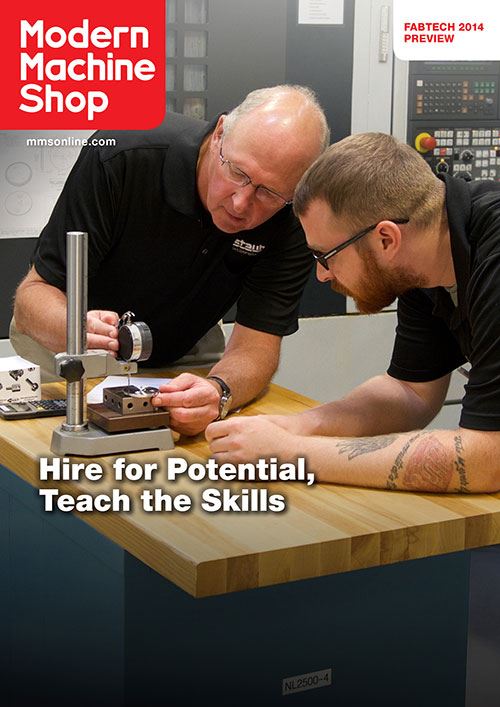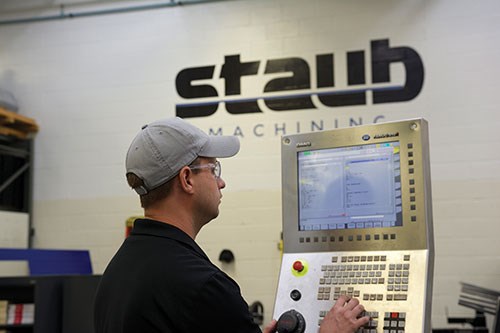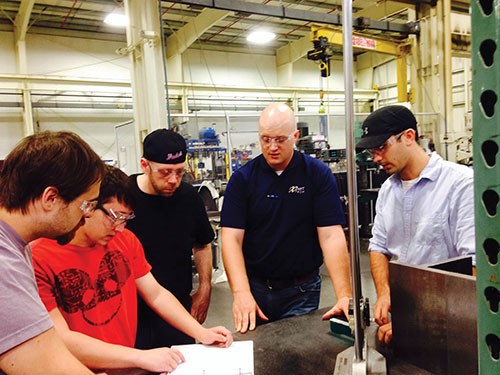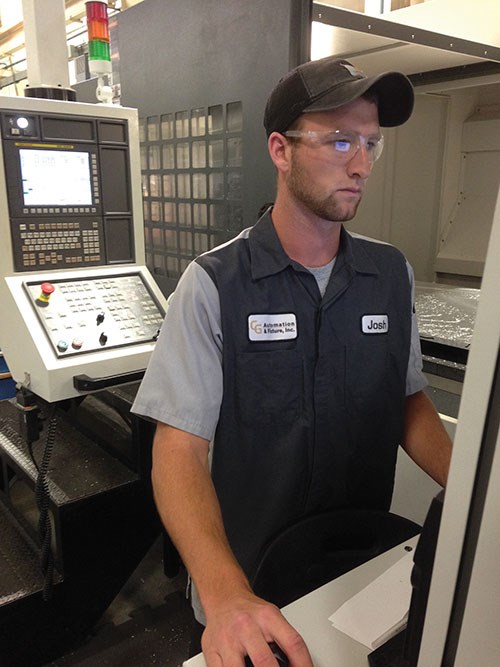Strengths First, Skills Later
The best indicators of a manufacturing employee’s success might be attributes that don’t appear on a résumé.
Share





Takumi USA
Featured Content
View More
ECi Software Solutions, Inc.
Featured Content
View More

.png;maxWidth=45)
DMG MORI - Cincinnati
Featured Content
View More

Tony Staub has completely reversed the way he thinks about evaluating and hiring new employees.
The founder, owner and president of Staub Machine Inc., a Hamburg, New York, machining business that employs 27 people, says he used to look primarily for skills and experience. If he had an opening on the shop floor, then he would generally prefer to hire the most accomplished or best-credentialed CNC machinist he could find. As a result, he employed people who engaged well with the machine tool, but in some cases did not engage as well with Mr. Staub, the other managers or the shop’s culture. Still, Mr. Staub saw this difficulty as a price worth paying, because machining skills are what he needed and he thought he couldn’t afford to train someone who did not have these skills.
Yet the personal mismatch itself could prove costly. Poor communication and the effect on morale could impede the shop’s performance, and thus ultimately impede its output. The extent of this effect is subtle enough that Mr. Staub didn’t see it easily, but over time, he gradually came to realize that the cost of such a mismatch is likely to be greater than the one-time expense of training an employee who personally fits very well with the organization but lacks the needed skills.
Today, Mr. Staub says he first evaluates personal attributes such as attitude and communication ability. Machining experience is a strong plus, but it is no longer paramount or even essential.
“There are probably six major factors I look at in evaluating a prospective employee,” he says. “Experience is number six on that list. And if this is the only thing missing, I will ignore it.”
For other manufacturing employers, Mr. Staub’s conclusion is encouraging, because many struggle to find experienced machinists even when this is what they’re seeking. But if the focus instead shifts to finding someone trainable as opposed to someone skilled—and, significantly, if the shop is willing to devote time and expense to training—then the local labor pool becomes much more promising than it otherwise might seem.
The Easy Part
Mr. Staub says an experience that began in 2006 helped crystallize this conclusion about whom to hire. That year marked the first time the shop added a staff member who simply seemed like a great fit, but who had no relevant background in manufacturing. In fact, the shop owner made a last-minute decision that year to bring this new hire to the International Manufacturing Technology Show. The decision was so late that finding a hotel room was a challenge—but the trip proved valuable. IMTS opened the new employee’s eyes, fueling him with something like the same enthusiasm for manufacturing technology that has filled Mr. Staub himself through 40 years in business.
“He ended up running our lathe department in a short period of time,” Mr. Staub says. A development in this man’s family led him to move out of state, so he doesn’t work for the company anymore, but the experience with this employee was enough to convince the shop owner to rethink his approach to recruitment.
Now, Mr. Staub works with a human resources consultant who evaluates prospects on characteristics such as the ability to learn. Mr. Staub looks for the same capacity himself—asking prospects, for example, how much reading they do. To test communication skills, he has them write. Job applicants are typically given four open-ended questions on a sheet of paper with instructions to answer in writing. The content of the answers is not necessarily what is important, he says.
“I could ask any questions. What I am looking for is whether applicants write just a paragraph per question or most of a page.” He also looks at whether the candidate answered the question asked, or whether the candidate failed to understand it and answered a different question instead.
Additional attributes important to Staub Machine’s culture include open-mindedness, flexibility to embrace change and youthfulness not in years but in spirit, he says. Also, integrity.
“If you don’t have a work ethic, I can’t change that,” he says, “but I can teach you how to run and program a lathe.” Training resources are available through community colleges or equipment providers, he points out—his own shop has used the training program offered by DMG MORI. “Technical training is the easy part,” he says.
Know Any Farm Kids?
Hundreds of miles away in Comstock Park, Michigan, Ryan Pohl of Expert Technical Training might not go so far as to say that technical training is “easy” (it’s his livelihood, after all), but he has independently come to a set of conclusions very much like those of Mr. Staub. Namely: Hard manufacturing skills are not the vital prerequisite for successful manufacturing employment. Instead, the proper “soft skills” and/or personal attributes come first, and these form the foundation on which a successful skilled manufacturing career can be built.
Mr. Pohl is president of the Michigan-based training firm, which provides both online and classroom instruction related to CNC machining and tool-and-die making. After starting this business in 2008, he struggled for nearly three years to get it to thrive. During this time, what he was missing wasn’t clear. He knew that manufacturing employers need skilled personnel (his previous role had been a trainer for a moldmaking facility that couldn’t find enough skilled help), but that need was not translating into business.
The lightbulb came on in 2011. “A customer called me and said, ‘Ryan, what we really need are people. You know, people like you—farm kids. Do you know anyone like that?’” Mr. Pohl’s realization was this: Employers were not opposed to sending people to training, but they were having trouble finding the people who were prospects for this training in the first place. These employers had not yet developed what Mr. Staub has developed: a mindset and a system aimed at evaluating people according to their personal strengths instead of their concrete skills.
Mr. Pohl decided to find these promising people himself. More than that, he decided to cultivate them. He designed a 12-week training program that begins with instruction in good work habits and professionalism before it proceeds into machining-related training. Five willing participants who were then unemployed served as his trial run for this program. Before the 12 weeks were even finished, he says, all five of these people had manufacturing jobs.
As a next step, he trained another five. The same thing happened.
Ditto with the next batch of seven people. Ditto with the next batch after that, eight. All of them quickly got jobs.
Now, nearly 150 people have been placed in manufacturing positions after being recruited by Expert Technical Training into instruction that builds manufacturing training onto a foundation of training in being a good employee. Today, matching trained-and-ready prospects with manufacturing employers is an important part of Expert’s business. The activity leads to further business for the firm, because as these employees succeed with their employers, they become candidates for Expert’s more advanced training.
Screening is critical, Mr. Pohl says. Expert rejects 80 percent of those who apply for the entry-level training. “This is a detail-intensive trade, so we read résumés closely, looking for details such as typos or errors in consistency,” he says. Evidence that an applicant is able to remain in the same job for a reasonable period of time is also important. In addition, he says he looks for experience in any hands-on job. Work experience as a chef, for example, has proven to be a good predictor of success.
How to Get Noticed
For those who enter Expert’s program, the first phase—nearly the entire first two weeks of instruction—consists of training that would apply in any workplace. According to Mr. Pohl, here is some of what this phase of the training aims to impart:
1. Personal accountability. “Part of our course material is the book, ‘The Question Behind the Question,’ by John G. Miller, which is about taking responsibility for your own life,” he says. Among the messages: Don’t procrastinate, be positive and don’t habitually blame others.
Mr. Pohl says the discussions in this area are intense enough that some students have come to tears. They realize perhaps for the first time in their lives that they have been responsible for their own situations all along.
“The world is not out to get you any more than it’s out to get the rest of us,” Mr. Pohl says.
2. Respect for employer’s time. Punctuality and attendance are “hammered,” he says. He teaches students that their break times on the job should be short. “Be the last one in the shop to go on break and the first one to resume work.” In addition, when walking through the workplace, he says, “move quickly,” showing a sense of purpose.
“You are trying to make a name for yourself. These simple steps will get you noticed, because most people don’t do this.”
A related point is the importance of being ready to work when the shift begins and continuing to work until the shift finishes. He takes care in his teaching to work through the example of someone who takes 30 minutes to begin working at the start of the shift and spends 30 minutes winding down before the shift ends, calculating for students how much money this lost 60 minutes per day will cost the employer over the course of one year.
3. Cell phone control. Today’s youngest employees have grown up with the constant presence of mobile phones ready to command their attention at any time, he notes. As a result, they don’t necessarily understand something that is plain to older people—namely, what a costly distraction it is to be obedient to the phone, and how much both effectiveness and safety suffer when concentration is repeatedly broken in this way. Mr. Pohl’s lesson to students: Just turn off the phone.
All of these lessons might seem obvious, he says, but that’s the point: The seeming obviousness of this teaching is the very reason why he himself did not initially pick up on the value of including it. To him it’s obvious, but not to everyone. Compared to generations past, many more people today enter adulthood without meaningful employment experience or mentoring related to these habits. The reasons for this societal change are open to discussion (Mr. Pohl has a view), but the result of the change is this: Basic points in how to be a good worker represent new information to many people. And if the recruiter has screened for the right recipient of the information, Mr. Pohl says, then these points are received as welcome insights that might well be taken to heart.
His instruction in this area is not all negative. In fact, if the points mentioned here seem scolding, he says, then that is not an accurate impression of the class. The theme he stresses most of all, repeating it in different ways throughout the 12-week program, relates to the importance of manufacturing and the worth of making things—not only for the sake of the strength of the nation, but also because of the dignity that comes from producing something so well that another person will be able to use it, benefit from it and be happier because they have it.
The Alternative to Vacancies
Mr. Staub, too, has noticed that the youngest generation of prospective employees is different from those who have come before. Their point of view is different, he says. He distrusts the criticism, “What’s the matter with kids today?” because the older generation has always said this. Given that he seeks open-mindedness, he needs to practice it himself. Thus, he has come to this take on the youngest generation of adults:
“Younger people today think more than their elders generally did about what they want out of life,” he says. That search affects their view of a job. “They consider—more than I ever did—things like time off, balancing work with the rest of their life, and the appeal, health and safety of their working conditions.”
He adds, “I envy them. I think they’re right.”
His observation of what employees want and what they value also shapes one additional element of his response to the challenge of finding employees—retention. “Keep the people you have and you don’t need to rehire,” he says. Particularly for younger employees, success at this retention is a function of not just wages, but also the experience of working for the company.
One aspect of this is relational, he says. Honesty is key. Tell employees the whole truth, he says, because “when you try to cover or hold back, they can see right through you.”
Another aspect of this, to Mr. Staub’s thinking, is compensation that expresses a commitment to the life and person of the employee. The company pays 100 percent of employee health insurance premiums and provides a fully employer-funded pension. Also, each employee receives a $2,000 annual allowance for education. This allowance is not targeted to technical training, but instead is available for anything the employee is interested in learning—whether welding or birdwatching. Limiting paid training just to what is narrowly relevant to the job is short-sighted, he says, because it misses the opportunity to encourage the employee’s growth. Again, he has observed that particular manufacturing skills are not necessarily what will lead to success. Instead, a fully engaged employee with an open and expanding mind is ultimately what will be of value to the company.
Related Content
How to Pass the Job Interview as an Employer
Job interviews are a two-way street. Follow these tips to make a good impression on your potential future workforce.
Read MoreThe Power of Practical Demonstrations and Projects
Practical work has served Bridgerland Technical College both in preparing its current students for manufacturing jobs and in appealing to new generations of potential machinists.
Read MoreCan Connecting ERP to Machine Tool Monitoring Address the Workforce Challenge?
It can if RFID tags are added. Here is how this startup sees a local Internet of Things aiding CNC machine shops.
Read MoreFinding the Right Tools for a Turning Shop
Xcelicut is a startup shop that has grown thanks to the right machines, cutting tools, grants and other resources.
Read MoreRead Next
Building Out a Foundation for Student Machinists
Autodesk and Haas have teamed up to produce an introductory course for students that covers the basics of CAD, CAM and CNC while providing them with a portfolio part.
Read MoreRegistration Now Open for the Precision Machining Technology Show (PMTS) 2025
The precision machining industry’s premier event returns to Cleveland, OH, April 1-3.
Read More



















.png;maxWidth=150)



























.jpg;maxWidth=300;quality=90)






